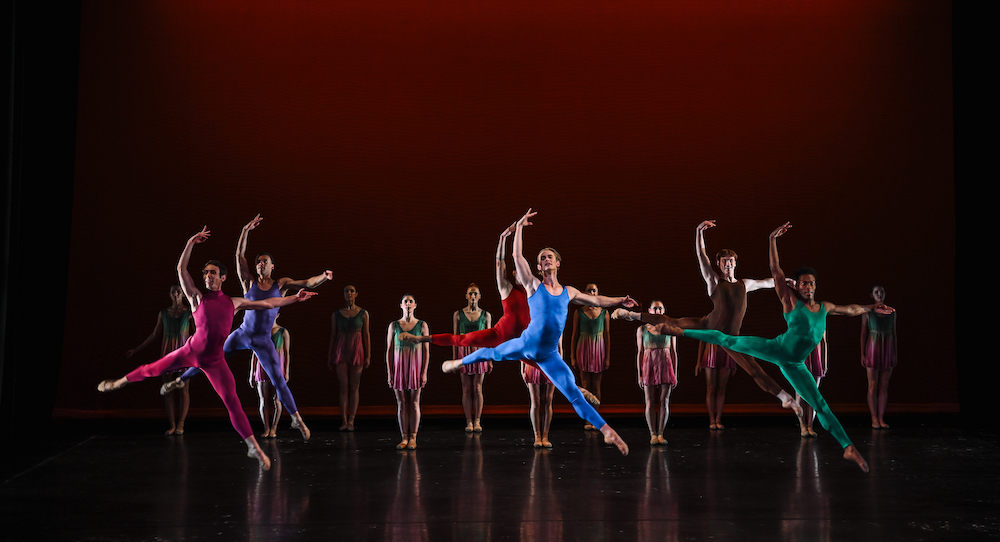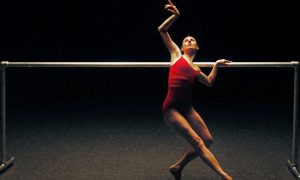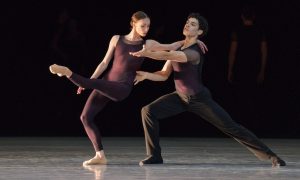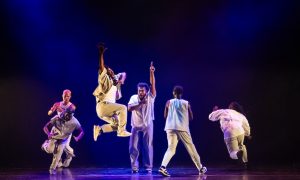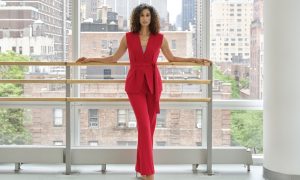Woodman Family Community and Performance Center, Providence RI.
October 26, 2025.
“How lucky are we to have art that reminds us that we’re in a season, that reflects the beauty all around us, that’s a beacon,” affirmed Kathleen Breen Combes, Ballet RI Artistic Executive Director, in her curtain speech. She received this reminder, she recounted, after suddenly seeing an astoundingly beautiful tree on a ride into the studios one morning (and wondering “how have I not noticed that before?”…certainly a relatable experience!). The moment helped her breathe a bit easier and feel a release of some of the heaviness that she had been feeling at the time, she shared.
This poignant, important reminder was also a fitting one to accompany the program, the company’s 2025-26 Season Opener. It was a collaboration with The Westerly Museum of American Impressionism, through which each of the three choreographers selected a painting as fodder to create an original work.
Such a multidisciplinary approach led to three world premieres that satisfied the senses, sparked the curious mind, and – as Breen Combes described – offered the spirit grounding. For a time, we in the audience could leave the weight of the world aside and delight in three unique worlds.
Emily Mistretta’s evocative and gripping Be Here Now, with inspiration from Edmond Greacen’s A Day at the Beach (1922), opened the program. In her “curtain” speech (delivered via video, as Ballet RI often presents them), she noted the painting’s foggy atmospherics. She often starts with atmosphere, she explained, so she aimed to create that enticing haziness in the piece.
With smooth gestures, rhythm ebbing and flowing, and keen visceral harmony, the work achieved that. Dancers leveraged length and dexterity to keep gestures easeful, yet also clear and sizeable enough to read. Movement employed line, spiral and undulation – flowing together, cresting and breaking, as naturally as the tide’s pull.
Even when the score shifted, leading the movement tempo to accordingly escalate, the ensemble maintained that sense of ease. Even when accent notably increased, continuous ebb and flow remained. In such ways, the work exemplified how seemingly opposite aesthetic or rhythmic qualities can smoothly cohere.
Mistretta also mentioned wanting to convey a sense of the “ragtime” era in which the piece was painted. A ragtime score (from Ethel Waters) – with tinny instrumentals and fuzzy voices, as if coming through an old radio – helped achieve that effect. White, lacy swimming undergarments also helped solidify the painting’s specific context (with Maxine Wheelock as Costume Manager). Such touchpoints can be effective anchors of understanding and meaning for audience members experiencing abstract dance.
Ensemble sections shifted into smaller groups. One dancer, simply stepping and gazing, starkly offset a pas de deux moving much more athletically. Other pas de deux brought more uncertain, even somber, weight to the ether. A solo, with the dancer dominating space, embodied the fierce and free feminine.
The work’s ending brought the ensemble back to the opening tableau, varied groupings across the stage as if scattered across a beach. I imagined the smaller groupings as windows into the little dramas – joys, annoyances and heartbreaks – of people spread throughout the setting. They might not know each other, but their experiences could be more similar than they know. In these ways the work made tangible the painting’s spirit, but created moving life far beyond it.
John Lam’s Impressions of Summer, drawing from Gifford Beal’s Garden Party (1914), was a treat of pure vibrancy. Lam mentioned being drawn to all the lush greens in Beal’s work, and that was certainly present – such as a green backdrop while dancers moved in silhouette to open the work (lighting design by Conor Mulligan). A rainbow of color filled the stage before long, however: with danseurs wearing unitards of varied bright colors, the ballerinas wearing short dresses with the soft color blends of flowers, and the backdrop shifting color according to changes in tempo and energy.
Lam also discussed the score, Rachmaninoff’s Symphonic Dances, in his introduction video. Many choreographers have been seemingly intimidated by the score’s epic scale, he noted, but he said “why not?” and dared to try. With the movement coming off highly musical, the score seemed to significantly contribute to the work’s effervescence: its speed, brightness, and size.
Lam also managed to meet all of that grandeur in the score without presenting multiplicity beyond what most audience members can absorb. Smaller groups also helped ease the energy and make the ensemble sections seem even more magically grand. Little vignettes with varied partner sets also implied a sense of what was in Mistretta’s piece: windows into more private interactions between people at the party, into their happiness and hurts and beyond.
Lam’s movement was classically-based (and fittingly enough, pairing with a Rachmaninoff score), yet also offered unique touches – of gesture, undulation, and shaping – that kept it from feeling stale, “done before, seen that.” The work therein demonstrated how classical movement can remain intriguing, relevant, and full of room for exploration.
The ensemble reassembled to fill the stage towards the end, moving with impressive size and quick timing for such a full stage (and thus delivering to us in the audience all the more ebullience). Lights came down on the dancers in silhouette before a vibrant green backdrop. Writing this now in mid-fall, the work had me feeling the warmth of summer in my spirit. With Lam having recently launched his own company, I very much look forward to seeing more of what he and fellow artists have to offer.
Yury Yanowsky’s bold and gripping The Bathers closed the program – based on Bathers / Perkins Cove by Charles H. Woodbury (date unknown). In his introduction video, Yanowsky explained that the painting reminded him of taking swims on a rocky Mediterranean beach in his youth. The score was from Senking, an artist whose music Yanowsky has enjoyed working with in the past few years, he also noted – so something much more recent.
The choice of score, or perhaps simply Yanowsky’s stylistic inclinations, are what seemed to shape the work’s aesthetic and tone: with a touch of mystery, edginess, perhaps even tension. The costumes of black swimwear and red caps matched what “the bathers” in the painting wear, yet – by offering something just a bit offbeat and unexpected – supported the work’s more edgy bent. Yanowsky’s movement felt just as unique. He has a way of making expansive shape and line blend with more intricate, smaller gesture so smoothly that it’s all just movement – entrancing movement, at that.
Accented tones drove gestures while resonating chords encouraged shaping of lines – all for a quite virtuosic outcome. A sky-high battement out to the side and up took dancers into turns, while their arms precisely shaped their negative space. A slide and reach preceded a spinal undulation, which then drew the limbs closer into the body: inner and outer energies blending. Heads that led rippling spines, in canon timing, created the effect of waves flowing into shore: line, spiral, and curve converging.
The dancers, for their part, demonstrated comfort and command in their execution of this approach; they’re up for Yanowsky’s challenge (and it certainly does seem a challenge). That’s also to the credit of Yanowsky, coaching, and other company leadership.
In his introduction video, Yanowsky additionally described having fun exploring with the “amazing” dancers, of enjoying how work evolves over time. That exploratory approach and recognition of what the dancers bring reflected in the work; the dancers appeared to move in ways that exhibited their strengths and supported them as moving artists. That speaks to an open, adaptive environment through the process.
The work closed with a flash of fluorescent light, illuminating the whole ensemble again onstage, before the lights fully went down (lighting by Conor Mulligan for this work as well): a nugget of mystery with which to finish and take out of the theater. To this critic, the most interesting questions – and potentially answers – can come from those nuggets of mystery.
Particularly when art forms come together and creative minds meet and meld, the sky’s the limit for the questions and answers that can emerge (or simply open questions, and that’s okay too). The aesthetic sense and the soul can be just as nourished. I eagerly await what else my mind, senses, and soul can savor next from this stalwart company – one bursting with compelling ideas and raw artistic talent. Until next time!
By Kathryn Boland of Dance Informa.


